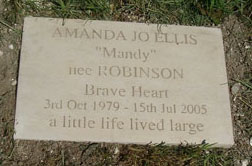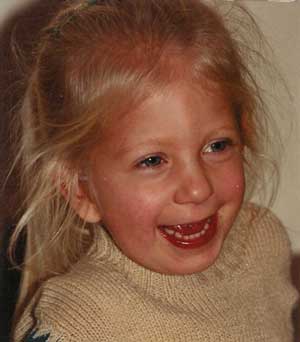 Mandy's story
Mandy's story
3 October 1979
After a hair-raising 19 mile dash in a mini at 6am to the maternity
hospital and a normal delivery, our fourth daughter, Mandy, arrived. Probably the earliest
she has ever been up in the morning! She was very ugly! We have no
photos of her at birth, she was pink and squashed looking. Later she
would become this beautiful blonde with the sparkling blue eyes. But
for now, although I knew her appearance would soon change, I still
felt there was something else about her that was not quite right.
Her sister, Jess, had been born 6 years before looking much the same
way as this new baby. Over the following weeks I discussed my growing
concern with my doctor and my health visitor, both of whom reassured
me that all was well, but I had a suspicion that they thought I was
just fussing. The more Mandy grew the more I knew something was wrong.
December 1979
In desperation I took Mandy with me to Jess's appointment with her
paediatrician and asked him if he would take a look at her. He was
a very approachable doctor. He examined Mandy whilst I took Jess
for an X-ray and on our return he asked me if I knew that Mandy had
a heart murmur. I said, no, I just thought her neck was short like
Jess's. He said, it is, and that is why I checked her heart because
the two often go together. He called it a syndrome, but didn't give
it a name, where the scoliosis, the heart problem and the limb
abnormalities occur in the same patient. But in our case, Jess has
the scoliosis and the limb abnormality and Mandy has the scoliosis
and the heart disorder. So I WAS right! He referred Mandy to a
Cardiologist and Jess's Orthopaedic Consultant.
Late 1979 - early 1980
An echo of Mandy's heart by a cardiologist revealed how complicated
it is. He himself wasn't sure he understood how it worked. It is
upside down, back to front (situs inversus) and in the wrong place
(dextra cardia). It has a large hole between the ventricles (VSD -
ventricular septal defect), a narrowing of the pulmonary artery
(pulmonary stenosis) and the aorta exits the right ventricle instead
of the left (DORV - double outlet right ventricle). Her liver is
also in the wrong place.
Summer 1980
Mandy started regularly losing consciousness for minutes at a time
every day. She was a very passive baby, not rolling over or
attempting to crawl yet, but she enjoyed her food!
September 1980
Catheterisation showed that Mandy needed a shunt.
November 1980
Mandy given a right side Blalock Taussig shunt. She recovered
very quickly and was soon crawling and in a short time walking
too. We were told that she would most likely require further
surgery at around 5 years of age. The operation would be very
dangerous to undertake and had a survival rate of 50% in a child
with a normally postioned heart, so for Mandy the rate was even
poorer. With that in mind they would wait as long as possible
before operating.
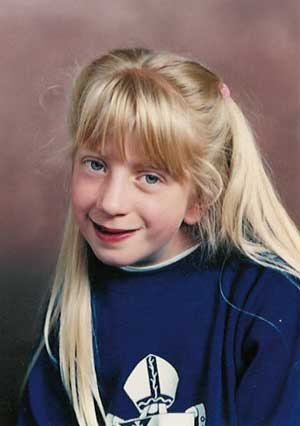
1980 - 1986
During these years Mandy attended heart clinic every 3 months and
orthopaedic clinic every 6 months. She also had physiotherapy
exercises toward the end. Sometimes we were there so much it felt
as if hospital was our second home. Mandy started school in 1984,
she could join in most things except games and PE. After a stalled
start at reading, she became a voracious reader and talker! Her
lack of physical prowess was made up for by her vocal ability. If
there had been a talking race on school sports day she would have
beaten everyone!
October 1986
Catheterisation showed shunt still working well.
1991
Underwent catheterisation for the third time. This time the
test showed that Mandy's shunt was closing and therefore more
surgery was needed. Two possible operations were explained to
us. 1) The most difficult option was, with one patch to close
the ventricular hole and divert the misplaced aorta. Also release
the narrowing of the pulmonary artery and expand it's diameter.
2) This option was to do a plumbing job outside her heart, which,
although easier, wouldn't give such a good result.
Preliminary date for the op: Spring 1992.
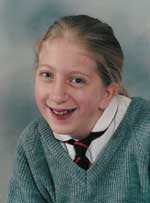
September 1991
Moved to her secondary school. She settled in quickly and made
a group of friends who stayed together for their five years at the
school. Mandy enjoyed school very much and was a "Hermione Grainger"
sort who sat in the front row, especially if she forgot her
spectacles, and was always ready with an opinion.
September 1992
Year 8 at school. Started using wheelchair about the school and
by October was too poorly to attend school at all.
26 November 1992
Mandy admitted to hospital for heart surgery. Weighing 6
and a half stones (91 pounds). She had high hopes of being
home by Christmas, but in case she didn't make it had charged
me with the distribution of her worldly goods.
30 November 1992
Operation day. I said goodbye to her at 8.45am. At this point
she was a much stronger person emotionally than me. I always
felt as if she was the one supporting me. I next saw her at 6.30pm.
She'd made it! The surgeon had been able to follow plan 'A',
ie. patch the ventricular hole and divert the aorta with dacron
and release the narrow pulmonary artery and expand it's diameter.
He had also found and patched a small atrial hole. Mandy was
looking great and keen to communicate and so devised a system of
drawing letters in the air. The message was, could she open the
first door on her advent calendar? She had done it before we
realised it was still only the 30 November!
1 December 1992
Communicating progressed to a clip-board and pen method. Mandy
was taken off the ventilator and breathed for herself, now she
could croak/talk too.
2 December 1992
The oxygen level in Mandy's blood started dropping and she was
given oxygen, but her breathing got shallower and shallower so
she was re-connected to the ventilator and given a drug to keep
her still. An infection in her lungs was suspected and she was
given an anti-biotic.
3 December 1992
Mandy awoke from the drug at around 5.30pm and started spelling
messages in the air: "I'm going to die"..... "rubbish," I said,
... "of thirst," she finished!
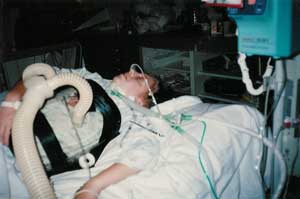 During the next two months the problems with her lungs persisted.
Lung specialists came to see her but they all disagreed as to the
cause. Mandy was given a tracheotomy and the nurses all said that
things would improve soon as a result, but no. Eventually one doctor
suggested trying an Oscillator. This is a sort of modern iron
lung, using negative pressure to inflate and deflate the lungs,
that had been invented for use on crash victims. At first
they had difficulty getting the vest part in the right size for
Mandy. Christmas came and went, and Mandy became depressed.
Her right leg was numb and her stomach was very upset too. At
last in the new year the oscillator did the trick and she was
weaned off the ventilator.
During the next two months the problems with her lungs persisted.
Lung specialists came to see her but they all disagreed as to the
cause. Mandy was given a tracheotomy and the nurses all said that
things would improve soon as a result, but no. Eventually one doctor
suggested trying an Oscillator. This is a sort of modern iron
lung, using negative pressure to inflate and deflate the lungs,
that had been invented for use on crash victims. At first
they had difficulty getting the vest part in the right size for
Mandy. Christmas came and went, and Mandy became depressed.
Her right leg was numb and her stomach was very upset too. At
last in the new year the oscillator did the trick and she was
weaned off the ventilator.
3 February 1993
Mandy returned home from hospital. She weighed just 5
stones (70 pounds), so she was very thin, with a croaky
voice, but pink! We were over the moon and full of hope
for her future.
February 1993
Over the next days I soon realised that things had changed.
She seemed to have lost her strong will and determination,
and for the first time I was supporting her. She had lost
her respect for the medical profession totally, and we had
monumental battles before each visit to any doctor. Then
Mandy had a chest infection, diagnosed by a locum when our GP
was away. He sent us straight back to the hospital, where
we were greeted with an angry: "what are you doing back here?"
and sent home again.
17 March 1993
Follow up appointment with the heart surgeon. I don't
remember anything about it.
March 1993 - December 1998
For over 5 years from this time Mandy attended appointments
every 3 months, later every 6 months, with her cardiologist.
We were told that she was doing well, a "star". Mostly she
felt most unstarlike and after the visit her spirits would
sink, but we were told it might take two years for her to feel
well again, so we lived in hope. As time passed she grew to
dread the appointments even more and vented her venom by refusing
to be seen by student doctors waiting to test their stethoscope
skills on her cacophany of murmurs.
April 1993
Mandy's right leg was often painfully swollen, especially when
the doctor suggested cutting down on her diuretic called
spironolactone, and so the dose would have to be increased again.
A scan of her leg did not clarify if there was a blockage of the
deep veins following her heart surgery.
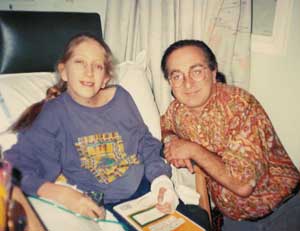 May 1993
May 1993
Mandy was admitted to hospital with a chest infection. She was
very poorly and needed oxygen. Tony Robinson alias Baldrick
came to see Mandy, and brought his mother. Mandy is a huge
Blackadder fan, so she was thrilled to bits. He lent her his
Blackadder videos and gave her copies of his Maid Marion books.
September 1993
Started back at school "full time", but suffered frequently from
chest infections, swelling of her right leg and stomach upsets.
She was rarely at school for a complete week. She used an electric
wheelchair and a stairmatic at school and another electric
wheelchair at home. A friend carried her school bag.
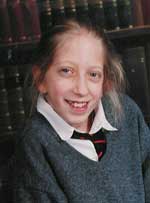
Summer 1994
Mandy gave up using the electric wheelchair at school, but used
the manual one for longer trips out.
August 1994
Admitted to hospital with suspected gastroenteritis.
3 January 1996
Mandy's cardiologist decided to start her on captopril. She was
admitted to hospital for this and one of her diuretics,
spironolactone, was stopped.
19 January 1996
Readmitted to hospital with heart failure. Dose of captopril
increased and spironolactone re-started.
January 1996
Mandy went to the orthopaedic clinic for the first time since her
heart op. The consultant said that in view of her heart condition
he could do nothing to remedy her scoliosis.
June 1996
Sat most of her GCSE exams and gained 5 A's, not at all bad
considering that she missed half of her five years at the school!
The school deserves an A for their tolerance and understanding! One
teacher said, if he had a pound for every time Mandy was cheeky he
would be a rich man!
September 1996
Started studying 3 A Levels at a new school.
May 1997
Mandy reluctantly decided to leave the sixth form. It was becoming
increasingly difficult for her to keep up with the A level work due
to frequent illness. All the moreso in the new school where she knew
no-one and no-one seemed to understand her problems.
June 1997
We discovered, when making Mandy some trousers, that her troublesome
right leg is 2cm shorter than her left! Previously I had assumed the
lop-sidedness was due to her scoliosis. She was prescribed a heel
raise and a scan of her right leg showed that the horizontal vein
behind her right knee is sluggish.
March 1998
I decided it was about time that the genetic side of Mandy's and Jess's
abnormalities was investigated. Our four daughters were adults now and
I wanted to be able to give them all the information available about
their genetic inheritance. So we were referred to a Genetic Consultant,
who first sent her assistant to our home to interview us.
May 1998
An appointment with the Genetics Consultant herself at her clinic. She
discussed the notes from the previous interview, examined Mandy and
explained, with the help of some old X-rays, how Mandy's neck vertebrae
were fused together, not missing completely. She expected this to be
the case with Jess's vertebrae also. She said she would arrange for
Mandy to have a lower body scan to see if any more of her internal
organs were misplaced.
12 October 1998
Scan of Mandy's lower body. It showed that she has a womb and at least
one ovary and two kidneys (Jess has only one kidney), in the correct
place. Her liver, heart and gall bladder are all on the wrong side of
her body and, strangest of all, Mandy has two spleens! Mandy's comment:
"Great! The one organ we don't need and I've got two of them!"
24 October 1998
I became very worried by how low Mandy's spirits were and together we
determined to do something about it. It was now six years since her
heart surgery and her quality of life was not improving, it was getting
worse. Mandy was due to move from paediatric cardiac care to the adult
sector during the next year, so we thought we would try to find the very
best adult cardiac care for her that we could. I wrote to the
Children's Heart Federation and a very understanding lady there
suggested we try the Royal Brompton Hospital(RBH) in London.
I found the RBH website and discovered that they had a special unit for
grown-up congenital heart patients (GUCH), just what we needed! I rang the
appropriate phone number and was given advice on getting Mandy referred
by our GP. He was agreeable but first had to obtain the approval of the
Health Authority for the funding, this he promptly did, we were on our
way.
18 December 1998
Mandy and I travelled to London by train for her first appointment
at the Royal Brompton Hospital. The walk from South Kensington tube
station highlighted how much worse Mandy was getting, she was very
blue on arrival. She was given all the usual tests. With no medical
notes to hand the docs spent a good while trying to pinpoint her
problems. And I knew she felt differently when she immediately
offered the arm with the better pulse for a blood pressure reading,
rather than trying her usual tease with the shunt arm.
5 January 1999
Admitted to GUCH unit, RBH for an MRI scan.
13 January 1999
Admitted to GUCH unit again for Trans-oesophageal echocardiogram
(TOE), unsuccessful due to Mandy's restricted throat.
24 March 1999
Admitted once more for catheterisation. Finally discovered
the reasons behind the sudden decline in her health. These were:-
1. that she still has a large hole at the back of her heart which is
allowing red and blue blood to mix
2. that her lungs have been under high pressure from too much blood
coming to them since 1992
The result of this is that no operation can be risked to fix the hole
because her lungs are too unfit to withstand it.
Strange to say but Mandy was relieved to hear this news because it
vindicated everything she had been feeling and saying for the past six
years since her heart surgery. There is something wrong.
May 1999
Mandy needed an electric wheelchair again.
December 1999
A heart/lung transplant was suggested at first, but this is now only
being considered as a very last resort, because:-
1. She goes blue from time to time and
2. She has had a lateral incision of her chest, (as a result of the
Blalock Taussig shunt she had as a baby), which tends to "stick the
lungs down" making it difficult to remove them.
So, she was told to enjoy the life that remained to her, and keep
taking the tablets!
4 September 2000
Mandy made a lifestyle change. She moved out from home to a little
one-bedroomed cottage in Tilshead, a village 3 miles away. I was
terrified(!), but she settled in with some regular care and made a
success of it.
March 2001
We had been warned of the first thing that might happen, her heart
going out of rhythm, and now she had a two and a half hour session
of palpitations. In true Mandy style they stopped spontaneously
just before she was attached to the ECG machine! The doctors were
keen to get a sample of them and a 24 hour monitor was arranged,
but throughout that time no palpitations appeared.
8 June 2001
She has fulfilled her dream of going to live in Salisbury, a city
friendly to wheelchair users, but as it will, life gave us a kick
in the pants just when we were getting complacent....
19 January 2002
A session of palpitations started at 7.40pm. at her friend Pippa's.
Pippa called an ambulance and it took Mandy to Salisbury Hospital, where
an ECG captured the palps at last. The docs faxed the results to the
Royal Brompton Hospital in London and docs there said try Amiodarone.
20 Jan 2002
It didn't work, so Mandy again went by ambulance to the Brompton. Her
blood pressure dropped dramatically and things were looking distinctly
dodgy. The only choice was to try cardioversion or electric shock to
you and me.
21 Jan 2002
It worked! The doctors were amazing, and Mandy's heart went back to
it's normal rhythm. We all breathed a sigh of relief! She will carry
on with the Amiodarone, which is an anti-arrhythmic drug, and will be
back with us again at the weekend, we hope!
26 Jan 2002
Taking longer than we thought. Mandy still recovering well and hopes
to be home next week.
30 Jan 2002
Mandy returned to her flat.
15 March 2002
Follow-up appointment at RBH. Everything fine. Mandy was told that the
Amiodarone should slow down the onset of any future sessions of
palpitations, but that she should phone the hospital soon if her legs
begin to swell more than usual as, if left, it could start palpitations.
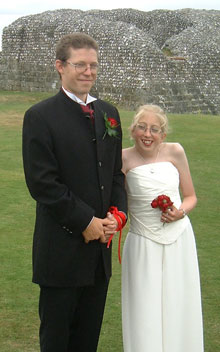 20 August 2003
20 August 2003
Mandy married her American boyfriend Andy, who she has been chatting to
on the internet for 4 years. After a short civil ceremony at Salisbury
Register Office they literally "tied the knot" at a handfasting ceremony
at Old Sarum, witnessed by 20 guests, including Andy's mother who had
flown over from Southern California.
May 2004
A two and a half year quest ended when Mandy's personal injury case against her previous hospital was settled out of court. However, she did not receive the apology she wanted.
21 August 2004
Mandy and Andy moved into a bungalow in Nursteed Road, Devizes, Wiltshire, that Mandy bought with her settlement. They were unable to find a suitable place in Salisbury, near enough to the town centre. The bungalow has enough bedrooms for the wheelchairs, computers and a future live-in carer as well as A & M. Also a huge kitchen, large enough to store Mandy's ever-increasing collection of kitchen equipment and cookery books, and a pretty garden with a pond full of frogs.
3 - 11 June 2005
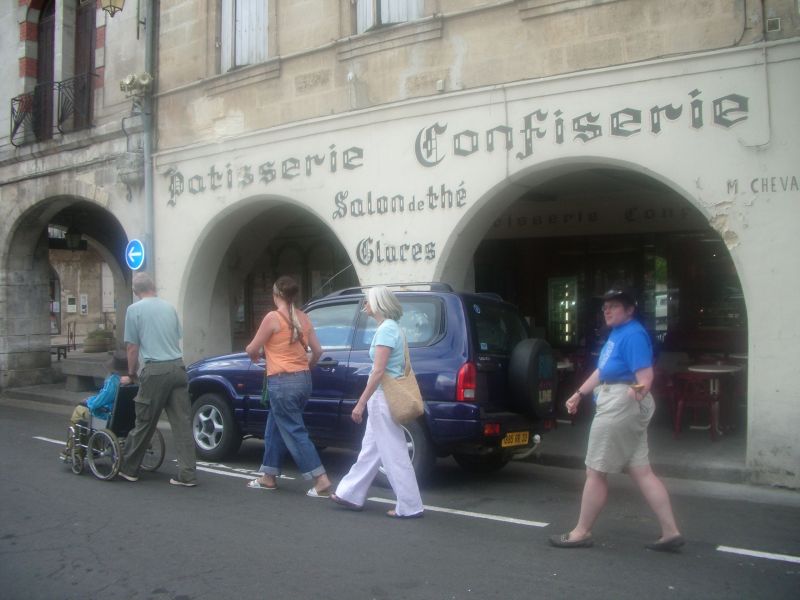 Our family went for a villa holiday to Margueron south of the River Dordogne in south-west France to celebrate my birthday. Kate and Amy came with us and Jess flew in from Munich on the 5th. Mandy had been tired by the hot weather and in and out of hospital with fluid retention for several months. She was reluctant to join us at first but was eventually persuaded to come by her doctors in London. She was advised not to fly so we drove and ferried, it was a long journey but we made it. We had superb weather the whole week and Mandy enjoyed it very much, visiting french street markets, dining in restaurants or barbecuing and lazing in the shade near the pool on a lounger piled high with cushions and duvets. It was to be the last time we would all be together.
Our family went for a villa holiday to Margueron south of the River Dordogne in south-west France to celebrate my birthday. Kate and Amy came with us and Jess flew in from Munich on the 5th. Mandy had been tired by the hot weather and in and out of hospital with fluid retention for several months. She was reluctant to join us at first but was eventually persuaded to come by her doctors in London. She was advised not to fly so we drove and ferried, it was a long journey but we made it. We had superb weather the whole week and Mandy enjoyed it very much, visiting french street markets, dining in restaurants or barbecuing and lazing in the shade near the pool on a lounger piled high with cushions and duvets. It was to be the last time we would all be together.
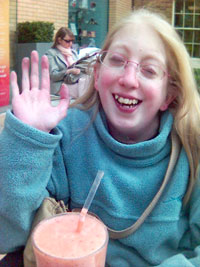 Tuesday 21 June 2005
Tuesday 21 June 2005
Mandy admitted to the RBH with exhaustion exacerbated by the hot weather. Dave drove her up while I stayed to look after my mother.
Wednesday 22 June 2005
I got a call from Lesley at the RBH telling me that they had no other treatment they could offer Mandy and that I should go up and spend some time with her. I arrived about 5pm and was given a bed in Mandy's room. She was attached to a dopamine drip and looked much the same as she had the previous day.
Friday 15 July 2005
Mandy died of heart failure in the early hours at the Royal Brompton Hospital, Chelsea, London.
I spent those last weeks with her in hospital, and we were able to go out sometimes with the wheelchair, when she wasn't attached to a drip. We went over the River Thames to Battersea Park with Dave, we explored the King's Road, we went to the cinema with sister Amy, and sometimes we ate out or ordered takeaways to eat in. On Wednesday 13th we'd had lunch at the Trafalgar on the King's Road. We drank Pimm's and ate delicious sausages and onions on foccacia. On Thursday Mandy was having a hard time. As the day progressed her breathing became more laboured, she could no longer lay in bed and sat in a reclining chair. I cooled her face with ice in a flannel as she struggled to breathe.
She died quite suddenly. I and a nurse were with her. It happened so quickly, a second or two and she was gone. As if her hold on life was like invisible thread. She was here one second and gone the next.
Kate and Amy arrived soon after, Dave was over two hours away. They were shocked, Kate had only visited us the previous day. None of us expected it so soon. We clung together as the truth refused to sink in.
Monday 25 July 2005
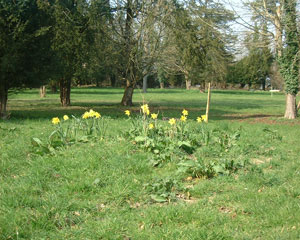 We buried Mandy's body in a wicker casket at Michael's Wood on a part of the Cholderton Estate just inside the Wiltshire border. During her last few months she had been reading a book called "The Natural Death Book" and had decided that she wanted to be buried in natural woodland. When she died she had already decided on a wicker casket, but hadn't chosen the site for her burial. The first few days after her death passed in a flurry of family activity as Mandy's sisters obtained compassionate leave from their work and threw themselves headlong into making Mandy's wishes for her funeral come true. We chose Michael's Wood because it was the most untampered with natural burial site we could find and, very importantly, it was in Wiltshire. Another problem was finding a local undertaker who would agree to organise such a burial. We struck gold when we discovered Elizabeth Snell in Trowbridge, who not only acceded to all our unusual requests without batting an eyelid and organised everything beautifully, but found us Judith Hall, a brilliant Humanist Officiant, to conduct the service at the graveside, and the celebration of Mandy's life back at our home. We were very pleased with the result and really felt we had done Mandy proud. Several of the guests remarked how much they liked the burial and the service, despite the unusual venue and arrangements, and some said it had really made them think. I'm sure this was what Mandy had in mind when she requested this sort of burial; she had always loved to shake tradition.
We buried Mandy's body in a wicker casket at Michael's Wood on a part of the Cholderton Estate just inside the Wiltshire border. During her last few months she had been reading a book called "The Natural Death Book" and had decided that she wanted to be buried in natural woodland. When she died she had already decided on a wicker casket, but hadn't chosen the site for her burial. The first few days after her death passed in a flurry of family activity as Mandy's sisters obtained compassionate leave from their work and threw themselves headlong into making Mandy's wishes for her funeral come true. We chose Michael's Wood because it was the most untampered with natural burial site we could find and, very importantly, it was in Wiltshire. Another problem was finding a local undertaker who would agree to organise such a burial. We struck gold when we discovered Elizabeth Snell in Trowbridge, who not only acceded to all our unusual requests without batting an eyelid and organised everything beautifully, but found us Judith Hall, a brilliant Humanist Officiant, to conduct the service at the graveside, and the celebration of Mandy's life back at our home. We were very pleased with the result and really felt we had done Mandy proud. Several of the guests remarked how much they liked the burial and the service, despite the unusual venue and arrangements, and some said it had really made them think. I'm sure this was what Mandy had in mind when she requested this sort of burial; she had always loved to shake tradition.

 Mandy's story
Mandy's story

 During the next two months the problems with her lungs persisted.
Lung specialists came to see her but they all disagreed as to the
cause. Mandy was given a tracheotomy and the nurses all said that
things would improve soon as a result, but no. Eventually one doctor
suggested trying an Oscillator. This is a sort of modern iron
lung, using negative pressure to inflate and deflate the lungs,
that had been invented for use on crash victims. At first
they had difficulty getting the vest part in the right size for
Mandy. Christmas came and went, and Mandy became depressed.
Her right leg was numb and her stomach was very upset too. At
last in the new year the oscillator did the trick and she was
weaned off the ventilator.
During the next two months the problems with her lungs persisted.
Lung specialists came to see her but they all disagreed as to the
cause. Mandy was given a tracheotomy and the nurses all said that
things would improve soon as a result, but no. Eventually one doctor
suggested trying an Oscillator. This is a sort of modern iron
lung, using negative pressure to inflate and deflate the lungs,
that had been invented for use on crash victims. At first
they had difficulty getting the vest part in the right size for
Mandy. Christmas came and went, and Mandy became depressed.
Her right leg was numb and her stomach was very upset too. At
last in the new year the oscillator did the trick and she was
weaned off the ventilator.
 May 1993
May 1993

 20 August 2003
20 August 2003
 Our family went for a villa holiday to Margueron south of the River Dordogne in south-west France to celebrate my birthday. Kate and Amy came with us and Jess flew in from Munich on the 5th. Mandy had been tired by the hot weather and in and out of hospital with fluid retention for several months. She was reluctant to join us at first but was eventually persuaded to come by her doctors in London. She was advised not to fly so we drove and ferried, it was a long journey but we made it. We had superb weather the whole week and Mandy enjoyed it very much, visiting french street markets, dining in restaurants or barbecuing and lazing in the shade near the pool on a lounger piled high with cushions and duvets. It was to be the last time we would all be together.
Our family went for a villa holiday to Margueron south of the River Dordogne in south-west France to celebrate my birthday. Kate and Amy came with us and Jess flew in from Munich on the 5th. Mandy had been tired by the hot weather and in and out of hospital with fluid retention for several months. She was reluctant to join us at first but was eventually persuaded to come by her doctors in London. She was advised not to fly so we drove and ferried, it was a long journey but we made it. We had superb weather the whole week and Mandy enjoyed it very much, visiting french street markets, dining in restaurants or barbecuing and lazing in the shade near the pool on a lounger piled high with cushions and duvets. It was to be the last time we would all be together.
 Tuesday 21 June 2005
Tuesday 21 June 2005
 We buried Mandy's body in a wicker casket at Michael's Wood on a part of the Cholderton Estate just inside the Wiltshire border. During her last few months she had been reading a book called "The Natural Death Book" and had decided that she wanted to be buried in natural woodland. When she died she had already decided on a wicker casket, but hadn't chosen the site for her burial. The first few days after her death passed in a flurry of family activity as Mandy's sisters obtained compassionate leave from their work and threw themselves headlong into making Mandy's wishes for her funeral come true. We chose Michael's Wood because it was the most untampered with natural burial site we could find and, very importantly, it was in Wiltshire. Another problem was finding a local undertaker who would agree to organise such a burial. We struck gold when we discovered Elizabeth Snell in Trowbridge, who not only acceded to all our unusual requests without batting an eyelid and organised everything beautifully, but found us Judith Hall, a brilliant Humanist Officiant, to conduct the service at the graveside, and the celebration of Mandy's life back at our home. We were very pleased with the result and really felt we had done Mandy proud. Several of the guests remarked how much they liked the burial and the service, despite the unusual venue and arrangements, and some said it had really made them think. I'm sure this was what Mandy had in mind when she requested this sort of burial; she had always loved to shake tradition.
We buried Mandy's body in a wicker casket at Michael's Wood on a part of the Cholderton Estate just inside the Wiltshire border. During her last few months she had been reading a book called "The Natural Death Book" and had decided that she wanted to be buried in natural woodland. When she died she had already decided on a wicker casket, but hadn't chosen the site for her burial. The first few days after her death passed in a flurry of family activity as Mandy's sisters obtained compassionate leave from their work and threw themselves headlong into making Mandy's wishes for her funeral come true. We chose Michael's Wood because it was the most untampered with natural burial site we could find and, very importantly, it was in Wiltshire. Another problem was finding a local undertaker who would agree to organise such a burial. We struck gold when we discovered Elizabeth Snell in Trowbridge, who not only acceded to all our unusual requests without batting an eyelid and organised everything beautifully, but found us Judith Hall, a brilliant Humanist Officiant, to conduct the service at the graveside, and the celebration of Mandy's life back at our home. We were very pleased with the result and really felt we had done Mandy proud. Several of the guests remarked how much they liked the burial and the service, despite the unusual venue and arrangements, and some said it had really made them think. I'm sure this was what Mandy had in mind when she requested this sort of burial; she had always loved to shake tradition.
